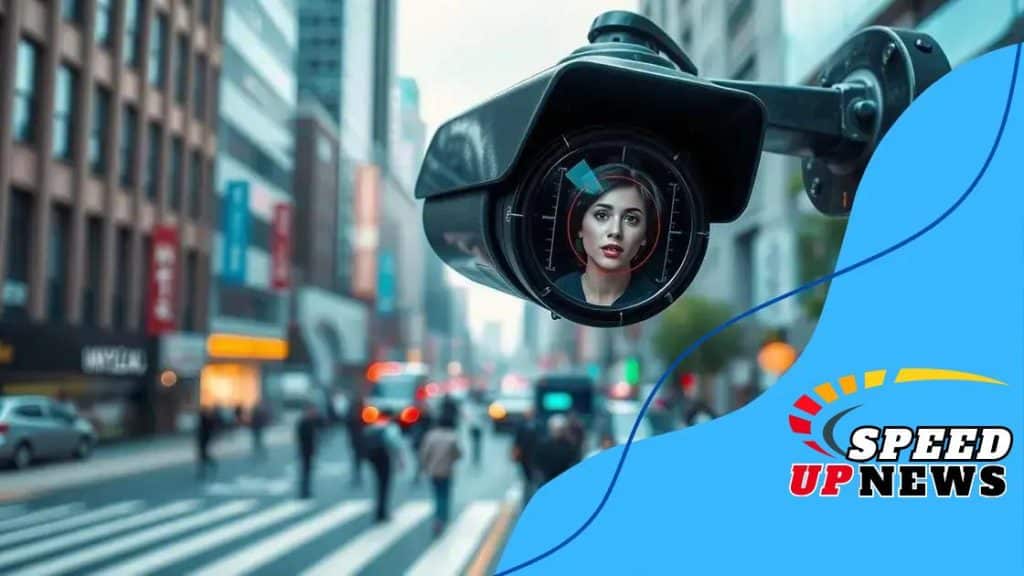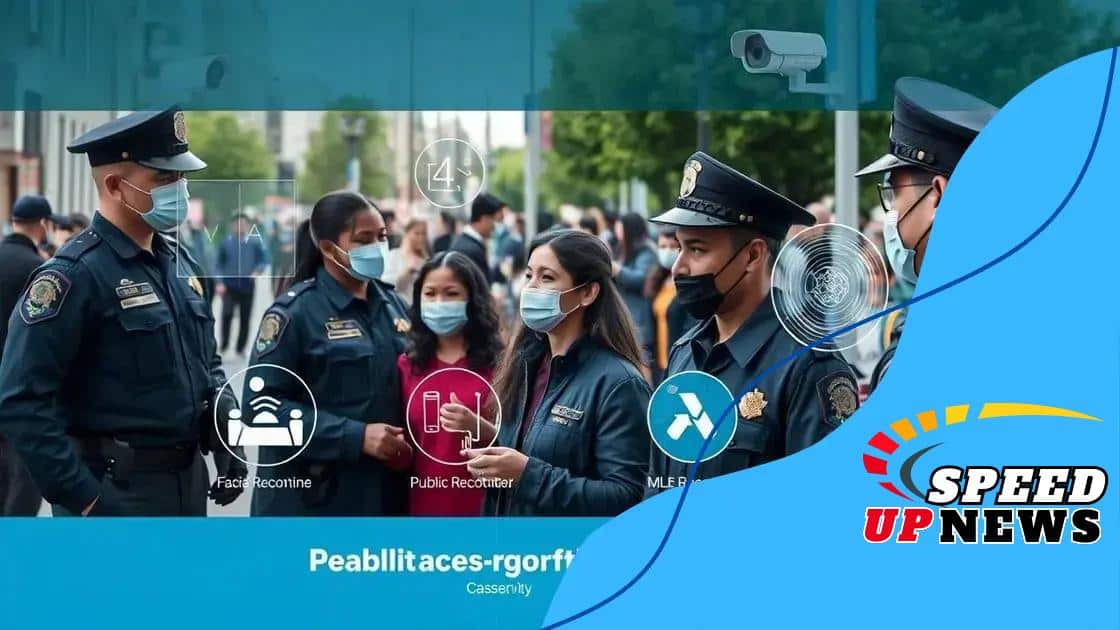The role of facial recognition in enhancing public safety

The role of facial recognition in enhancing public safety involves its use for rapid identification of suspects, crime prevention through surveillance, and improving emergency response, while also raising important privacy concerns.
The role of facial recognition in enhancing public safety can’t be overlooked. It’s becoming increasingly integral to how communities ensure safety and security. Have you ever wondered how your local authorities utilize this technology?
Understanding facial recognition technology
Understanding facial recognition technology is essential in today’s digital world. It’s used widely, from smartphones unlocking to complex security systems. The tech uses algorithms to identify faces by taking unique features from a picture and comparing them to a stored database.
How Does It Work?
The process starts with capturing an image, which can be from a camera or a smartphone. This image is then converted into a digital format. Next, the software analyzes various facial features like the distance between your eyes, the shape of your jaw, and the outline of your face.
- Images are converted into mathematical data.
- The system searches a database for matches.
- Identification takes just seconds.
This technology has improved significantly over the years. Early systems had high error rates, but advancements in AI and machine learning have made it much more reliable. Many cities now use it for enhanced public safety.
Applications in Daily Life
Facial recognition is not just for security. It’s also present in everyday applications. For example, social media platforms automatically tag friends in photos. Retailers use it to personalize shopping experiences. By recognizing customer faces, they can tailor recommendations.
- Social media tagging for easy sharing.
- Retail personalization for improved customer experience.
- Secure financial transactions with biometric verification.
This dual use in security and convenience showcases the breadth of applications for facial recognition technology. When used responsibly, it can provide benefits while ensuring that privacy concerns are addressed.
Applications of facial recognition in law enforcement
Applications of facial recognition in law enforcement have gained significant traction as technology advances. Police departments across the globe are adopting these systems to improve crime-solving efficiency and enhance public safety. This technology helps law enforcement agencies to quickly identify suspects and prevent criminal activities.
Real-Time Monitoring
One major use of facial recognition is in real-time monitoring. Cameras placed in public areas can analyze faces and alert authorities if a match is found in a criminal database. This allows for faster responses to potential threats.
- Immediate identification of wanted individuals.
- Increased surveillance capabilities at public events.
- Enhanced safety in crowded places.
With the rise of large gatherings, law enforcement agencies can significantly reduce risks. This technology provides an additional layer of security.
Criminal Investigations
Facial recognition also plays a crucial role in criminal investigations. After a crime occurs, investigators can use facial recognition systems to scrutinize footage from nearby cameras. This helps identify suspects who might not have been known to the police.
- Linking facial data from various crime scenes.
- Aiding in solving cold cases with new technology.
- Enhancing the accuracy of witness testimonies.
It’s fascinating to see how this technology can link unrelated incidents. By analyzing facial data, law enforcement can build connections that were previously invisible.
Challenges and Concerns
Despite its benefits, there are concerns about privacy and misuse of facial recognition technology. Critics argue that constant surveillance may infringe on individual rights. It’s crucial for law enforcement to balance safety with civil liberties, ensuring that data is used responsibly.
As facial recognition technology continues to evolve, its impact on law enforcement will likely increase. Ongoing discussions about ethics, regulations, and best practices are vital for its future use.
Benefits of facial recognition for public safety

Benefits of facial recognition for public safety are numerous and impactful. This technology enhances security in various environments, making communities safer. By employing advanced algorithms, facial recognition systems identify individuals quickly, which helps prevent crime and manage emergencies.
Crime Prevention
One of the most significant benefits is its ability to aid in crime prevention. By monitoring public spaces, law enforcement agencies can deter potential offenders. When people know they can be identified, they are less likely to commit crimes.
- Reduced theft and vandalism in high-security areas.
- Immediate alerts when known criminals are detected.
- Increased overall community safety.
These features make facial recognition a powerful tool in maintaining law and order.
Emergency Response
Facial recognition also plays a crucial role in enhancing emergency response efforts. During critical incidents like natural disasters or terrorist threats, identifying individuals can be key. Emergency teams can quickly gather data and coordinate their responses effectively.
- Quick identification of missing persons.
- Enhanced situational awareness for first responders.
- Streamlined communication between agencies.
The ability to identify people in real-time can make a difference between a timely rescue and a disaster.
Community Engagement
Moreover, facial recognition can improve community engagement. When used in conjunction with public safety initiatives, it fosters trust between law enforcement and citizens. By involving the community in safety programs, agencies can gather valuable feedback and improve their services.
With the right frameworks in place, facial recognition technology can bridge the gap, ensuring safety while respecting privacy. As cities evolve, the importance of these systems for public safety will only grow.
Privacy concerns surrounding facial recognition
Privacy concerns surrounding facial recognition technology are a hot topic. As this technology becomes more prevalent, many people worry about how their personal data is used and protected. The idea of constant surveillance can make individuals feel uncomfortable and vulnerable.
Data Collection Practices
One major concern is the way data is collected. Facial recognition systems often store images without user consent. These systems take snapshots from public cameras or even social media platforms. This raises questions about who owns the images and how they can be used.
- Potential misuse by unauthorized personnel.
- Storing data without individuals’ knowledge.
- Lack of transparency in data handling.
Without clear regulations, people are understandably anxious about their privacy rights when it comes to facial recognition.
Surveillance and Its Impact
Another issue is the impact of surveillance on daily life. Constant monitoring can create a chilling effect where individuals feel they are always being watched. This may lead to a change in behavior, where people avoid certain activities or places out of fear of being identified.
Moreover, there are concerns about biases in facial recognition systems. Studies show that these technologies often have higher error rates for people of color and women. Such biases can lead to wrongful accusations or increased scrutiny of certain groups.
Legal and Ethical Considerations
Discussions about legal and ethical standards are essential as well. Many countries do not have strict rules governing facial recognition technology. Without proper laws, individuals have limited recourse if their data is misused.
As technology evolves, these concerns need to be addressed. It is crucial for stakeholders to work towards a framework that respects privacy rights while allowing for the benefits of this technology. Public awareness and advocacy can drive the changes needed to protect individuals in the digital age.
Future trends in facial recognition technology
Future trends in facial recognition technology are exciting and rapidly evolving. As technology advances, we can expect substantial improvements and new applications across various sectors. From law enforcement to retail, the future is bright for facial recognition.
Enhanced Accuracy
One significant trend is the move toward enhanced accuracy. Developers are continuously refining algorithms to minimize errors, especially for diverse populations. Better training with varied datasets means fewer false positives and negatives, making this technology more reliable.
- Improved identification for all demographics.
- Higher success rates in security applications.
- Decreased likelihood of biased outcomes.
These advancements can lead to greater public trust in facial recognition systems.
Integration with AI and IoT
Another trend involves the integration of artificial intelligence (AI) and the Internet of Things (IoT). As smart devices become commonplace, facial recognition will likely work seamlessly with various technologies. For example, smart home devices may recognize individuals and adjust settings based on their preferences.
This interconnectedness can create personalized experiences in retail and public spaces, enhancing customer satisfaction.
Privacy and Ethical Frameworks
Future developments must also address privacy and ethical concerns. As facial recognition becomes more widespread, establishing clear regulations will be crucial. Companies and governments need to ensure they use this technology responsibly, with consent and transparency leading the way.
Debates on ethical implications will likely gain momentum, pushing for frameworks that protect individual rights while allowing for innovation. Engaging the public in these discussions is essential for balancing safety and privacy.
Global Adoption
We can also anticipate a rise in global adoption of facial recognition technology. As countries recognize the benefits, we may see increased investment and implementation across different regions. This could help standardize practices and create interoperability between systems worldwide.
With these trends shaping the landscape, the future of facial recognition technology looks promising. Adapting to new challenges while focusing on ethical practices will be essential for its growth and acceptance.
In conclusion, the future of facial recognition technology holds great promise. As it continues to evolve, we can expect improvements in accuracy, integration with AI and IoT, and a growing emphasis on privacy and ethical frameworks. Policymakers and industry leaders must work together to ensure this technology benefits society while safeguarding individual rights. By understanding its potential and addressing concerns, we can embrace a future where facial recognition enhances public safety and convenience for all.
FAQ – Frequently Asked Questions about Facial Recognition Technology
What is facial recognition technology?
Facial recognition technology uses algorithms to identify and verify individuals based on their facial features. It is commonly used for security and personalization.
How does facial recognition enhance public safety?
Facial recognition enhances public safety by helping law enforcement quickly identify suspects and preventing crimes through real-time monitoring.
What are the privacy concerns associated with facial recognition?
Privacy concerns include data collection without consent, potential misuse of personal images, and the effects of constant surveillance on individual behavior.
What future trends can we expect from facial recognition technology?
Future trends include improved accuracy, integration with AI and IoT devices, stronger privacy frameworks, and increased global adoption for various applications.





